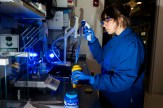Challenges, opportunities ahead for repairing nation’s aging infrastructure

President Donald J. Trump underscored repairing the nation’s aging infrastructure as a national priority both throughout the campaign and in his inauguration address. Senate Democrats last week also unveiled their own $1 trillion plan. But how did the country’s infrastructure fall into a state of such disrepair? What are the greatest challenges facing an infrastructure boom? And how can engineering foster innovation and the development of new technology to address this national priority? We asked Jerome Hajjar, CDM Smith Professor and chair of the Department of Civil and Environmental Engineering.
The American Society of Civil Engineers’ 2013 Report Card assigned a grade of “D+” to the country’s overall infrastructure and will issue its next report card in March. In a nutshell, how did we get to this point?
The country went on a significant construction boom after World War II, including building out the federal highway system as well as the energy sector and mass transit. It’s been 50 to 60 years for many of these systems since a lot of the new construction was completed. That’s certainly part of the issue. Infrastructure components are designed with a design life. Usually it’s about 50 years for these systems; for some it’s longer and for some it’s shorter. Some will last longer, but they will eventually break down.
Infrastructure requires consistent, significant investment from the public and private sectors.
Jerry Hajjar
CDM Smith Professor and chair of the Department of Civil and Environmental Engineering
One clear example of this is what’s happened with the nation’s bridges. They have heavy loads traveling over them every day that over time cause fatigue in the steel and cracking and failure in concrete. If this is not addressed, the bridges become deficient and, at a certain point, become dangerous. The federal government and private sector are continually assessing these issues but oftentimes don’t have adequate funds to do the necessary assessments, let alone proper replacement and repair. That’s how we’ve gotten to this point. Infrastructure requires consistent, significant investment from the public and private sectors.
[Hajjar and his colleagues are developing a sophisticated system that uses autonomous small flying robots coupled with 3-D imaging and state-of-the art planning, modeling, and analysis to inspect structures such as bridges.]
What are the greatest challenges facing a national imperative to repair this aging infrastructure?
The greatest challenge, in my opinion, is simply having adequate funding—recognizing that this is a national priority for the public and private sectors, and that this investment pays off in many ways over time. From there, I think there is a lot of opportunity. Approaches have been developed in recent years that are sustainable, that incorporate materials that use less energy and come from recycled materials. While it is a challenge to rebuild the infrastructure in a highly sustainable way, I also see this as an opportunity. However, we’re still developing and designing infrastructure systems that have design lives. It’s not like we can design them to last hundreds of years; they will require continued attention. In addition to age, it’s important to consider the way in which we’re using our infrastructure and the ability to predict what will happen and how people will interact with each other in and out of cities. For example, how will autonomous vehicles affect the nation’s infrastructure, and are there ways to design transportation infrastructure to take advantage of this? These questions are really interesting.
Are the infrastructure systems under development now adaptable enough to shift as our needs change in the future?
This is an area in which more research is needed, and to some extent we’re doing that work here at Northeastern. Adaptability can come in a variety of forms, in terms of predicting changes in function over time and using new materials that can be brought in during replacement cycles. As one example, we’re doing research for design for deconstruction, which means taking buildings apart at the end of their useful lives and reusing their components. This has implications for sustainability, in terms of materials use and construction, but it can also aid adaptability. Making more components modular might facilitate adaptability over time. But there are also many challenges to overcome.
In our department, we’re talking about urban engineering—a new generation of solutions for complex urban regions. As it relates to infrastructure, this means going beyond thinking about each component in an isolated fashion and considering it in the context of a complex urban environment. We’d like to start incorporating these issues into design as we move forward.
How can engineering play a role in balancing the short- and long-term needs of repairing our nation’s infrastructure?
This balance is a constant challenge in engineering design projects. For example, work has been done for many years on lifecycle assessment and cost, considering the idea of incorporating the cost of maintenance into the design. Some might argue this increases the initial cost of construction, but it could save money over time. Oftentimes the initial construction costs control much of decision-making. ASCE and other organizations have been trying to incorporate these ideas in a cost-effective way to link the short- and long-term more tightly. But there are tradeoffs and issues that aren’t fully resolved. It’s interesting in the building profession when you have owners working with architects and engineers, they’re interested in talking about aesthetics. But as soon as the conversation turns toward maintenance, lifecycle assessment, and sustainability, the calculator comes out, and they start calculating extra cost. To overcome this is going to require a culture shift in infrastructure owners and the public at large to recognize that this kind of investment is really in our best interest. As this begins to shift more and more, I think engineering will be able to develop solutions that are as cost-effective as possible.
We’re doing research for design for deconstruction, which means taking buildings apart at the end of their useful lives and reusing their components. This has implications for sustainability, in terms of materials use and construction, but it can also aid adaptability.
Jerry Hajjar
CDM Smith Professor and chair of the Department of Civil and Environmental Engineering
You’re part of a research team building airborne robots coupled with 3-D imaging and software that can to inspect bridges. How can innovations and new technologies like these play a role in rebuilding the nation’s infrastructure for the future?
There are some huge opportunities here. There has been some great work going on across the world for years, and Northeastern is a leader in many of these aspects. We’re a leader in sensing and development of sensors for infrastructure and data informatics for infrastructure assessment and planning.
In addition to the work I’m doing on autonomous robotics for infrastructure inspection and damage protection, Ming Wang leads the VOTERS center with Sara Wadia-Fascetti, where they develop new sensors to mount on vehicles that drive ubiquitously through traffic to assess the health of roadways and bridge decks.
Haris Koutsopoulos is using data analytics and informatics methods for using ubiquitous data for transportation infrastructure, particularly mass transit, which he processes to assess how the system is being used and how it can be improved for the future.
Matt Eckelman is doing great work across topics related to lifecycle assessment and sustainability, in terms of identifying inefficiencies in the use of energy and materials.
We have faculty such as Andy Myers looking at the energy infrastructure, and we are working to help Massachusetts become a leader in offshore wind. There’s enough wind energy off the east coast to power the entire country, but there are logistical issues related to that. But the size of the resource is huge.
We’re developing new structural systems that are more sustainable and that can better withstand extreme loads and have replaceable components. So after an extreme event, instead of having to condemn a structure, you can replace the damaged component more effectively. If we can do that alone across our infrastructure, it will transform how we address maintenance in the future.





